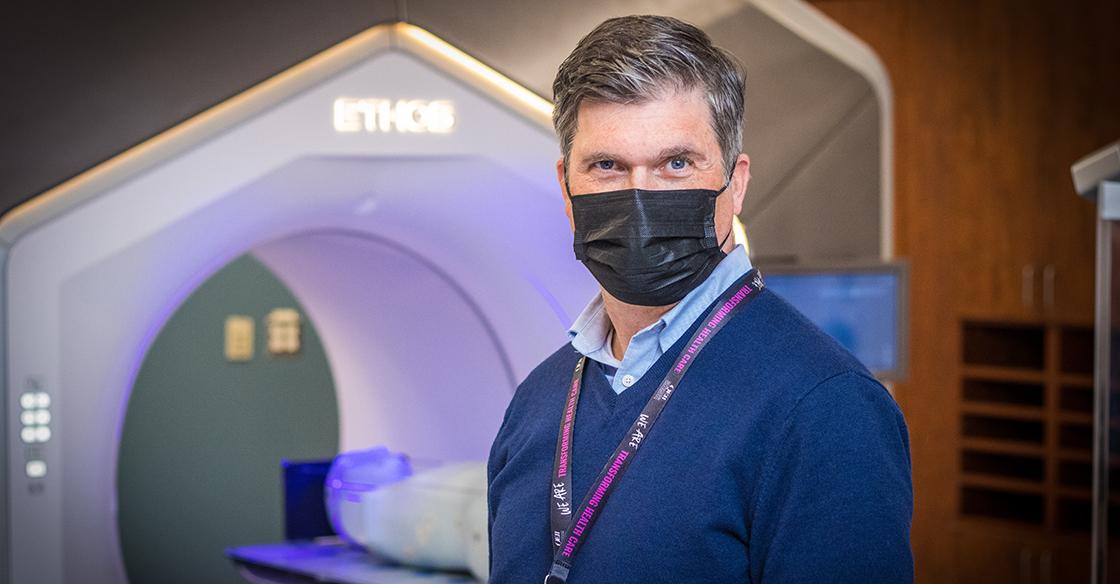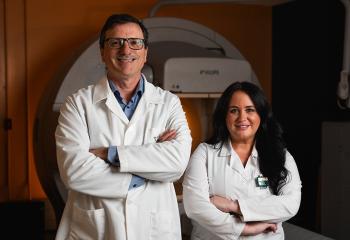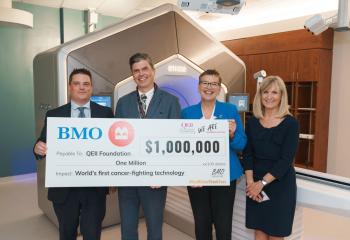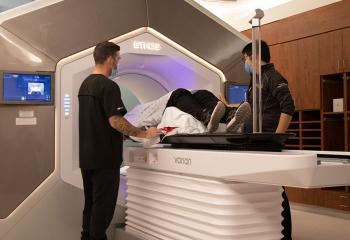
Dr. James Robar, chief of medical physics for Nova Scotia Health and a professor of radiation oncology at Dalhousie University, stands in front of Ethos, an innovative treatment platform that allows cancer care experts to deliver radiation treatment in a hyper-precise way. Made possible by an $8.5-million QEII Foundation fundraising campaign, this new radiation technology that has the potential to transform cancer treatment on a global scale. PHOTO CREDIT: Nova Scotia Health
World firsts in cancer care are happening within the walls of the QEII Health Sciences Centre and donors are at the forefront of making that happen.
Earlier this year, the QEII Foundation announced completion of an $8.5-million campaign to fund new radiation technology that has the potential to transform cancer treatment on a global scale.
This milestone was reached with the support from many donors including a $1-million donation from BMO, a $500,000 matching gift from the WM Fares Family Foundation, a significant investment from the MacDonald family and the Jack and Joan Kiuru Foundation, along with many other contributing groups and individuals, including riders and supporters of the 2022 BMO Ride for Cancer.
With the initiation of a clinical study, the QEII has become the first hospital in the world to obtain images of human trial participants on an Ethos therapy system equipped with the new HyperSight™ imaging technology. The Ethos system is designed to enable clinical teams to deliver adaptive radiotherapy, which allows the clinician to adjust the patient's treatment plan to reflect changes in the tumour or surrounding tissue, in real time during a treatment appointment.
QEII cancer care experts are working with industry collaborator, Varian, on this next-generation advancement that holds significant promise for radiation therapy.
Dr. James Robar, chief of medical physics for Nova Scotia Health and a professor of radiation oncology at Dalhousie University, describes the technology as an innovative treatment platform that allows cancer care experts to deliver radiation treatment in a hyper-precise way.
“Ethos is a quantum leap in the way we can potentially target tumours and keep up with changes within a patient’s anatomy during a multi-day course of radiation therapy,” he says.
“It leverages state-of-the-art imaging to get exquisite pictures of our patients in three dimensions, then it uses that imaging to adapt the patient’s day-to-day treatment.”
Paired with the world’s first HyperSight imaging technology, Ethos enables real-time, high-quality images of the patient’s tumour, organs and surrounding tissue – capturing all this information in just six seconds.
The image acquisition process can occur within one single breath hold, about 10 times faster than conventional linear accelerator-based imaging systems.
Fifty per cent of patients diagnosed with cancer will require radiation at some point during their cancer journey. The ground-breaking treatment method has the potential to one day transform how those patients receive care and offer a new kind of precision medicine.
That precision could result in a host of potential benefits, including fewer side effects and better treatment outcomes for patients.
Healthcare experts are already starting to take notice. To date, two additional medical physicists have been recruited to the QEII to work with this Ethos system featuring HyperSight technology.
Susan Mullin, president and CEO of the QEII Foundation, commends all donors who supported this visionary project, especially BMO, the MacDonald family, and the WM Fares Family Foundation.
“The QEII Foundation is grateful to have such visionary philanthropists believe in our mission to transform care,” she says. “Personalized radiotherapy is one extraordinary example of the projects the QEII Foundation is focused on funding, through our We Are campaign. Better access to care, first-in-the-world technologies, improving wait times and patient outcomes, with research and innovation intersecting every project – that’s what We Are is all about.”
Justin Scully, BMO’s regional president of personalized banking in the Atlantic provinces, says he is proud to see the bank step up in support of cancer care.
“For patients, access to this technology could mean their radiation treatments have the potential to be more precise than ever before, and it’s almost hard not to get emotional thinking about the impact that could have on patients and families, says Justin. “I think that all our employees at BMO can be proud of that potential impact.”
Dr. Gail Tomblin Murphy, vice president of research, innovation and discovery at Nova Scotia Health, knows this new technology will make a big impact.
“We believe this remarkable technology will truly transform the lives of Nova Scotians,” says Dr. Tomblin Murphy. “Nova Scotia Health’s Innovation Hub is proud to provide the kind of adaptable, agile, and creative space for researchers, clinical teams, partners, and investors that helps us capitalize on solutions brought forward by the brightest minds. And with the generosity of donors, I know we’ll continue to see even more innovation in health care that will have impact regionally, nationally and globally.”
Research work utilizing HyperSight on the Ethos system is ongoing at the QEII, following the Investigation Testing Authorization granted by Health Canada.
"We are eager to evaluate the potential benefits of HyperSight, including how it may enhance the patient experience," Dr. Robar says. "The ability to acquire high-quality images during the normal course of treatment and in just six seconds provides an exciting opportunity to potentially deliver more efficient, comfortable care.
“I feel like this is the next chapter in radiation oncology,” he says. “It’s the next big leap as we strive to deliver better care and achieve better outcomes for our patients.”


